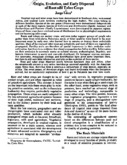Mostrar el registro sencillo del ítem
Origin, evolution, and early dispersal of root and tuber crops
| dc.contributor.author | León, J. | |
| dc.date.accessioned | 2014-10-18T02:29:31Z | |
| dc.date.available | 2014-10-18T02:29:31Z | |
| dc.date.issued | 1976 | es_ES |
| dc.identifier | 352997 | es_ES |
| dc.identifier.uri | http://orton.catie.ac.cr/repdoc/A7165i/A7165i.pdf | es_ES |
| dc.identifier.uri | https://repositorio.catie.ac.cr/handle/11554/3279 | |
| dc.description | 1 tab. 51 ref. Sum. (En) | es_ES |
| dc.description.abstract | Tropical root and tuber crops have been domesticated in Southeast Asia, West-Central Africa, and tropical Latin America (Including the high Andes). The crops belong to different families. Species of the one genus (Dioscorea) were domesticated independently in each of the three regions. Species of Colocasia and Xanthosoma (family Araceae) and Pachyrrhizus and Pueraria (family Leguminosae) were domesticated in separate regions. Many of these crops have restricted areas of distribution due to physiological requirements and are becoming relict crops. Roots and tubers are ancient crops, and even today support groups of people who gather them from wild plants. Poisonous, acrid, or bitter qualities were found in the most important crops by early man, who learned how to remove or destroy these undesirable qualities. Most of the root and tuber crops are polyploids, and most of them are vegetatively propagated. Fertility traits are therefore of special importance in their evolution under cultivation, but there is no evidence that clonal propagation has led to sterility. Information on their evolution is extremely scarce as cultural sources, archaeological, linguistic, and historic information is scanty and unevenly distributed. On biological sources, comparative taxonomy, metaphase cytology, and hybridization have given some important clues, but there is still very little information available on the evolution of these species. Root and tuber crops dispersed slowly between Southeast Asia and Africa. After the seventeenth century a very active interchange occurred especially with the American crops. Since then, there has been a continuous replacement of crop species, especially in Africa. The sweet potato, of American origin, was found in Oceania when the Europeans arrived, but no satisfactory explanation of how it got to Polynesia has ever been made. | es_ES |
| dc.language.iso | en | es_ES |
| dc.publisher | CATIE, Turrialba (Costa Rica) | es_ES |
| dc.subject | PLANTAS DE RAICES COMESTIBLES | es_ES |
| dc.subject | PROCEDENCIA | es_ES |
| dc.subject | EVOLUCION | es_ES |
| dc.subject | POLIPLOIDIA | es_ES |
| dc.subject | PROPAGACION VEGETATIVA | es_ES |
| dc.subject | MUTACION | es_ES |
| dc.subject | USOS | es_ES |
| dc.title | Origin, evolution, and early dispersal of root and tuber crops | es_ES |
| dc.type | MON | es_ES |
| dc.identifier.publication | Turrialba (Costa Rica) | es_ES |
Ficheros en el ítem
Este ítem aparece en la(s) siguiente(s) colección(ones)
-
Publicaciones y documentos [4167]


